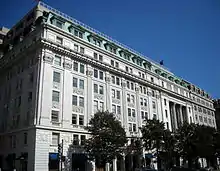B. Stanley Simmons
Benjamin Stanley Simmons (March 10, 1871 – September 8, 1931) was an American architect.
B. Stanley Simmons | |
|---|---|
| Born | Benjamin Stanley Simmons March 10, 1871 Charles County, Maryland, U.S. |
| Died | September 8, 1931 (aged 60) Washington, D.C., U.S. |
| Alma mater | Massachusetts Institute of Technology |
| Occupation | Architect |
| Buildings | Hume School, National Metropolitan Bank Building, Fairfax Hotel, Barr Building |
Life
Born in Charles County, Maryland, in 1872, Simmons came as a child came to Washington, D.C., where he would later establish his career in architecture.[1] He received his architecture degree at the University of Maryland, and continued his study at MIT.[2] He started designing and building houses in the 1890s, before he moved on to bigger commissions.[3] In 1902, the Evening Star described Simmons as "an architect who has added to the beauty and growth of this city."[1][4]
He established himself as an extremely prolific architect, ultimately designing more than 280 buildings in the city.[2] Simmons worked with every major developer, and appears to have had a particularly close working relationship with Lester A. Barr and later his son, John L. Barr, with whom he designed some of his best-known commissions.[2] Simmons was versatile, designing a variety of building types including row houses, fraternal clubs, and commercial and institutional buildings. He seems to have had a proclivity for apartment buildings, of which he designed more than 60. Among his other works are the National Metropolitan Bank Building at 15th and G Streets NW (1905), the Elks Club at 919 H Street NW (1908, demolished); and the Fairfax Hotel at 21st and Massachusetts Avenue NW (1921).[3] His earlier Hume School, built in 1891, is on the National Register of Historic Places, along with the National Metropolitan Bank Building, the Wyoming Apartments, and the Barr Building.[5]

Although he never studied at the École des Beaux-Arts, Simmons became a student of the Beaux Arts tradition and the City Beautiful Movement. While his 19th-century speculative row houses reflect Victorian styles of architecture, his early 20th-century buildings are grander and more monumental structures that reflect a variety of academic styles inspired the City Beautiful movement, including the Classical Revival style and Renaissance Revival.[2]
Simmons died in 1931 at 60. He was survived by a son, B. Stanley Jr., and 11 grandchildren.[1] Many of his buildings were recognized in the late 20th century.
References
- Johnson, Jane Simmons (February 15, 1997). "An Architect's Legacy". The Washington Post.
- "910 17th Street NW - Barr Building, Application for Historic Landmark or Historic District Designation". DC Office of Planning. May 17, 2000. Retrieved 25 February 2019.
Architect B. Stanley Simmons (1872-1931) was born in Charles County, Maryland in 1872, but came to Washington as a child where he later established his career in architecture. Simmons received his architecture degree at the University of Maryland, and later studied architecture at M.I.T.
- "Capitol Hill Architects and Builders". Capitol Hill Restoration Society. Archived from the original on 2011-11-08. Retrieved 2011-10-03.
- "Prosperous Washington and the Men Who have Made It: His Work Excellent". Evening Star. December 16, 1902. p. 4.
- "National Register Information System". National Register of Historic Places. National Park Service. March 13, 2009.